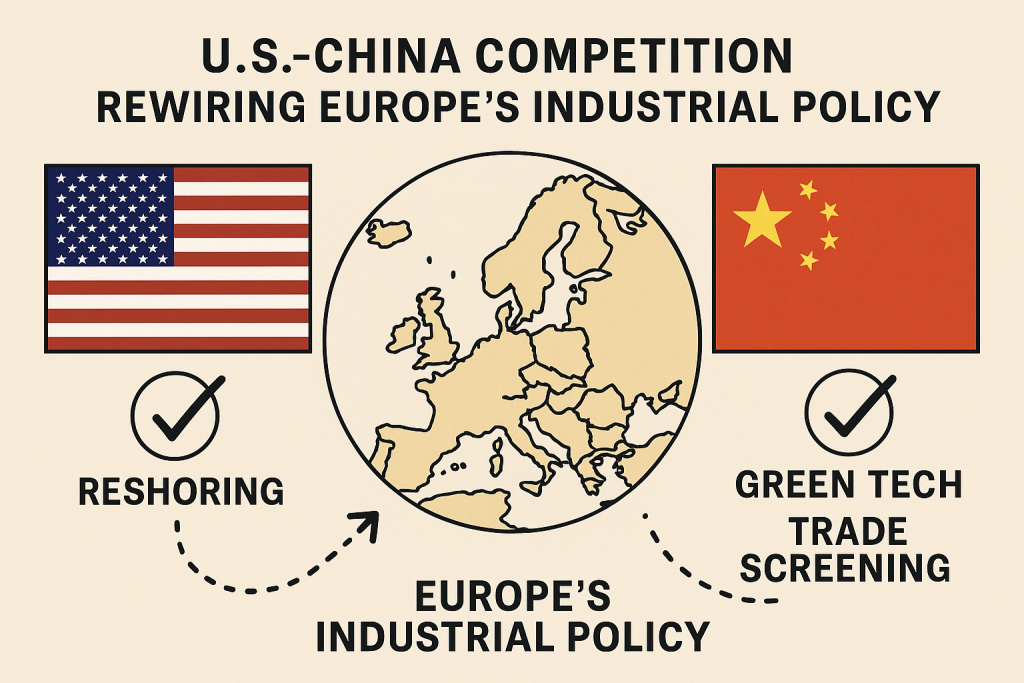
How is Europe navigating the stormy waters of the intensifying U.S.-China rivalry? As China’s trade policy becomes more assertive and U.S. sanctions on China disrupt global markets, the European Union is being forced to rethink its industrial foundations. With EU reshoring strategies accelerating and Europe-China relations shifting under the weight of global trade tensions, the stakes for economic sovereignty have never been higher. At the same time, foreign direct investment in Europe is being reshaped by geopolitics more than ever before. In this blog post, you’ll discover how the clash between Washington and Beijing is fundamentally rewiring Europe’s industrial policy—and what that means for the continent’s future competitiveness, security, and strategic autonomy.
The growing U.S.-China rivalry has become a defining force in global geopolitics and economics. While Washington and Beijing are the principal players in this power game, Europe is finding itself caught in the middle, forced to rethink its industrial policy to remain competitive, sovereign, and secure. The intensifying U.S.-China economic competition is not only impacting global supply chains but also transforming the European Union’s (EU) approach to trade, technology, and green energy.
Europe’s Strategic Dilemma Between the U.S. and China
Historically, the EU has maintained strong economic ties with both Washington and Beijing. However, the increasing polarization with the U.S. promoting decoupling from China and Europe facing pressure to follow suit, is creating a deep policy dilemma. The effects of the U.S.-China trade war have rippled through European markets, impacting sectors such as autos, semiconductors, and rare earths. China’s trade policy, often seen as opaque and state-subsidized, has raised alarm over market access and competition fairness in Europe. Meanwhile, the U.S.’s Inflation Reduction Act has triggered European concerns over potential industrial flight to America.
In response, Europe’s industrial policy is undergoing a paradigm shift, signaling a move toward greater strategic autonomy.
China’s Green Tech Dominance and Europe’s Response
One of the most visible fronts in this rivalry is green technology, especially solar panels, EV batteries, and rare earth processing. China’s green tech dominance poses both an opportunity and a challenge for Europe. While cheap Chinese imports accelerate green transitions, they undercut EU manufacturers. The EU’s Net-Zero Industry Act, proposed in 2023, is part of an effort to strengthen domestic production of clean technologies and reduce dependency on China. European policymakers now emphasize resilience, sustainability, and competitiveness: a strategic response to both U.S.-China trade tensions and climate commitments.
How Europe is Adapting to U.S.-China Competition
In adapting to this global rivalry, Europe is pursuing three approaches:
- Reshoring and Diversification:
EU companies are looking beyond China to “friendlier” nations (India, Vietnam, Mexico) for manufacturing and sourcing. This de-risks supply chains and insulates Europe from future trade shocks. - Digital Sovereignty and Industrial Subsidies:
The EU’s Digital Compass and Chips Act aim to boost local innovation in semiconductors and digital infrastructure, lessening reliance on both American and Chinese tech giants. - Tighter Trade Screening:
The EU is increasingly scrutinizing Chinese investments in strategic sectors, particularly in infrastructure, telecommunications, and AI.
Impact of the U.S.-China Trade War on EU Industries
From automotive manufacturing in Germany to aerospace in France, the impact of the U.S.-China trade war on EU industries has been significant. For example, Tariff instability affects export planning and pricing strategies, and Regulatory divergence forces firms to navigate dual standards for U.S. and Chinese markets. Strategic sectors face growing calls for industrial sovereignty and public-private partnerships to bolster domestic capacity.
Conclusion
The intensifying U.S.-China rivalry is doing more than disrupting global trade—it’s compelling Europe to redefine its industrial and strategic path. As China’s trade policy challenges market norms and U.S. sanctions on China reshape supply chains, the EU is responding with bold initiatives like reshoring strategies, green tech investment, and tighter controls on foreign direct investment in Europe. The evolving dynamics of Europe-China relations and growing global trade tensions are accelerating the shift toward industrial resilience and digital sovereignty. Europe is no longer a passive observer—it is actively forging its place between two global superpowers.
As the U.S.-China competition deepens, Europe is adapting with a more assertive and strategic industrial approach. The impact of the U.S.-China trade war on EU industries has exposed vulnerabilities in critical sectors, prompting shifts in supply chains, innovation policy, and investment strategy. China’s role in reshaping European tech policy—from green tech to semiconductors—has accelerated the EU’s pursuit of strategic autonomy in industrial planning. In response to China’s green tech dominance, Europe is investing in sustainable technologies and domestic capabilities. Ultimately, the future of EU manufacturing in a polarized world hinges on its ability to balance global dependencies with internal resilience. Europe is no longer just reacting—it’s redesigning its industrial identity to thrive in a contested global order.
